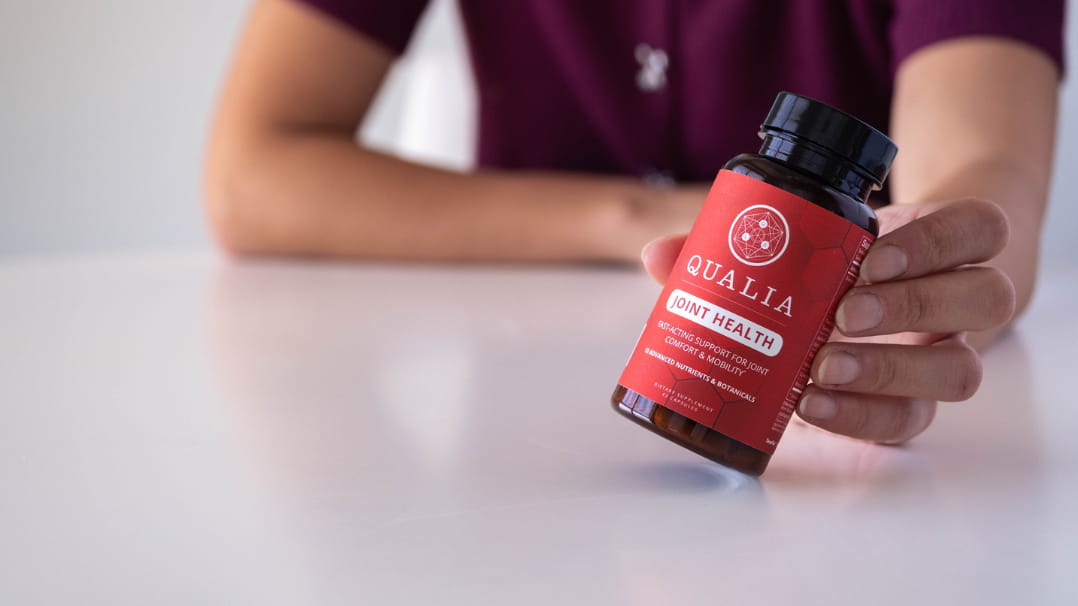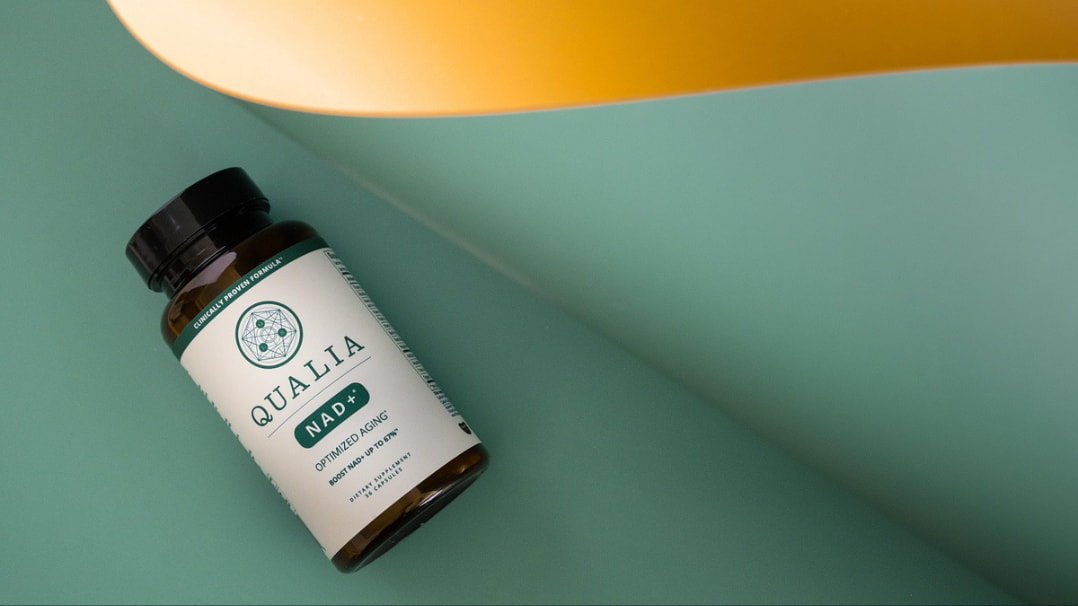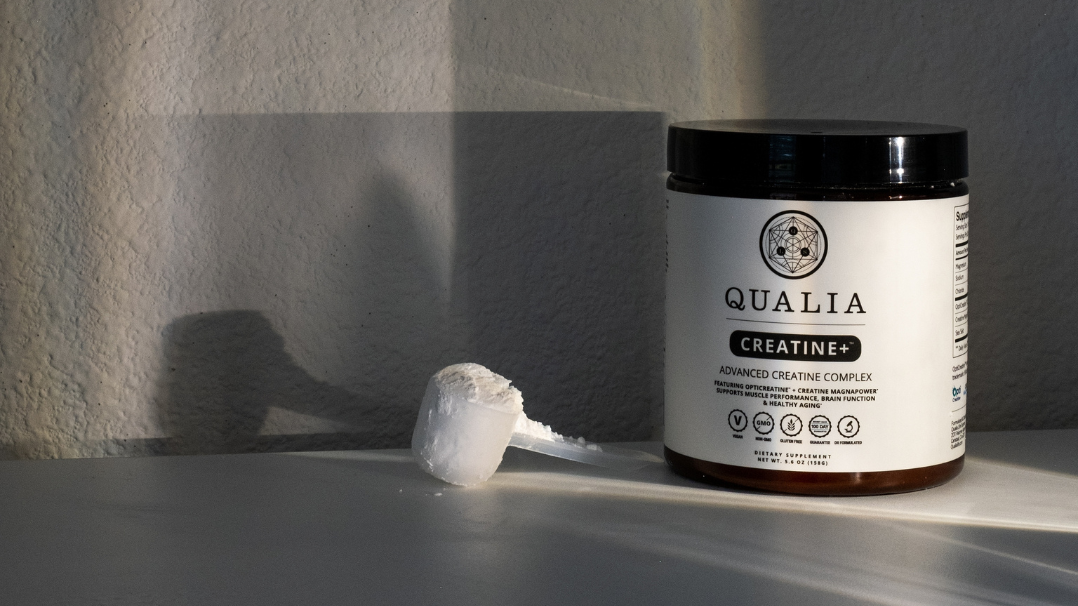Why did we create QUALIA JOINT HEALTH? Our goal is to support high-performance and healthy aging. Mobility is central to both, and, at its heart, this new product is about supporting mobility.* But what does that mean?
Mobility is about movement, but it means more than that at Qualia Life Sciences. It means being able to move freely and easily. It means being able to participate in the types of activities and exercises that are most important to you, whether that’s running, swimming, bicycling, walking, dancing, yoga, pickleball, playing with children or grandchildren, gardening, or something else. We want people of all ages to be able to be active and move comfortably, because we think it may be the single most important factor for healthy aging.*
What most directly impacts a person’s ability to experience mobility in the ways that are important to them? The answer is physical structure, including joints, ligaments, muscles, and tendons. As one example, post-workout muscle soreness and temporary exercise-induced inflammation can interfere with the next exercise session and fun activities we want to do in between exercise sessions. We want to get you back in the game faster!
A stiff lower back or uncomfortable joints is another example. These types of structural challenges are common at all ages and more common with the passage of time. They can make it easier to stay sitting rather than getting up and moving, or can impact our ability to work or participate as fully as we may want in life. We want to support you in living your best life.*
There are many things that can hold you back from living a healthy, active lifestyle. We don’t want the health of your joints and tendons to be one of them. Movement and flexibility are, in a real sense, freedom …freedom to travel, to exercise, to play, and to live life to its fullest. We want to support you in being more free to move comfortably and engage in activities at any age. That’s why we created QUALIA JOINT HEALTH.*
During the development of QUALIA JOINT HEALTH, the Qualia science team researched, evaluated, and ranked more than 80 possible ingredients. And some of the ingredients have more than one version—there are about a half dozen clinically studied eggshell membrane extract brands (we included one of them as Ovomet®).* When ingredients and all of their different studied versions are considered, we evaluated well over 100 potential ingredients. Below I’ll share with you why we chose the ones we did.
As you read through each ingredient, please keep one thing in mind. Our team wants to be able to exercise more, play more, and do more. And we want this for our older relatives. We created QUALIA JOINT HEALTH to be an innovative way to support us, them, and you in getting moving and keeping moving at a younger and older age. It was created to be your all-in-one mobility partner.*
A Few Notable Studies
Don’t just take our word for it. These are a few publications from scientific journals highlighting some of the QUALIA JOINT HEALTH ingredients. I’ll go into more detail about each of them below.
TamaFlex® supported walking distance and speed, lower body strength and endurance, and joint function (Pubmed 37351019).*
AprèsFlex® supported mobility and helped preserve cartilage health (Pubmed 39700461).*
A 2024 Meta-Analysis concluded eggshell membrane (like Ovomet®) is a promising supplement for knee health and overall quality of life (Pubmed 39203777).*
Haritaki fruit extract has been combined with Boswellia and Turmeric extracts for support of joint comfort (Pubmed 29708818).*
L-carnitine supported joint comfort and biomarkers of collagen maintenance (Pubmed 26933897).*
Boron supports healthy bones and joints (Pubmed 7889887).*
Qualia Joint Health Ingredients
Ovomet® Eggshell Membrane
I mentioned that a 2024 Meta-Analysis concluded that eggshell membrane is a promising supplement for knee health and overall quality of life (1). I agree 100%! Eggshell membrane has not received the wide use it deserves for supporting areas of healthy function like joint and tendon health, beauty-from-within (skin health), and exercise performance.* In fact, I wouldn’t be surprised if QUALIA JOINT HEALTH is the first time many customers have encountered eggshell membrane in a dietary supplement. So I’ll start by sharing what it is.
Eggshell membrane is a sustainable, upcycled ingredient made from leftover eggs—a food byproduct that would otherwise be thrown away. The membrane is the thin film lining the inside of an eggshell and is mostly made up of protein (~90%) in bioactive forms including collagen, hyaluronic acid, elastin, glucosamine, and glycosaminoglycans (like chondroitin sulfate). Some of them, like collagen, glucosamine, and chondroitin sulfate, you've probably heard of. Others you may not have. Hyaluronic acid (the "goo" molecule) is a lubricating substance found throughout the body, especially in the eyes, joints and skin. Elastin is a stretchy protein that gives elasticity and flexibility to tissues like some ligaments and skin. It shouldn’t be a surprise, given this matrix of biomolecules, that eggshell membrane has been primarily studied for supporting healthy joints, tendons, and skin.*
While there’s a few clinically studied brands of eggshell membrane, Ovomet® was the clear choice for us. We liked it for several reasons. It is a vegetarian source of undenatured or native collagen, which means it retains its biologically active form and has not been modified or denatured during the manufacturing process. Ovomet has been clinically researched for supporting mobility and joint health (2), tendon strength (3), and skin appearance (4, 5) in studies that have included men and women, active athletes, relatively sedentary individuals, and both older and younger adults. One of our favorite studies was done in athletes, where Ovomet supported Achilles tendon elasticity and strength (3), which is important for areas of sports performance such as producing greater rates of force, faster sprinting, and improved running economy. Ovomet is made in Spain and contains 22% undenatured collagen (66 mg per serving) along with a matrix of biomolecules including hyaluronic acid ( 9 mg per serving). We use 300 mg to match the amount used in studies.*
Ovomet® is a registered trademark of eggnovo.
L-Carnitine
The name carnitine is derived from Latin “carnus” (flesh), because it was originally found in meat extracts. Animal products—meat, poultry, fish, and milk—are the best food sources, with redder meats tending to have higher levels of L-carnitine. Adults eating animal products consume about 60-180 milligrams of carnitine per day (6). QUALIA JOINT HEALTH is unique and innovative for a number of reasons. One is the inclusion of Ovomet, which is essentially all but missing from the U.S. market. Another reason is the inclusion of L-carnitine, which is rarely found in joint health supplements despite its importance for supporting their healthy structure and function.*
L-carnitine is a conditionally essential nutrient. One of its nutritional roles is supporting the mitochondrial conversion of the fat we eat into the energy our bodies rely on to stay healthy. Like all tissues, joints need energy—ATP—to stay healthy. They use ATP to maintain cartilage, produce joint lubricating and cushioning fluid, and make essential biomolecules needed for healthy joint structure and function, such as glycosaminoglycans (including chondroitin sulfates), collagen, and hyaluronic acid. Unfortunately, mitochondrial dysfunction is a hallmark of aging (7). Joints, like other tissues, are not immune from its impact, including on ATP production (8–12). This is where L-carnitine enters the picture; it supports healthier mitochondrial energy production, and hence joint functions like maintenance and lubrication (13, 14).*
In a simple sense, L-carnitine supports joint cells in making ATP, and with more optimal amounts of ATP available, joints are able to make the healthy amount of the molecules they need to keep themselves lubricated and flexible. In a human clinical study, presumably at least in part because of this joint energy function, L-carnitine supplementation supported joint health and cartilage maintenance biomarkers (15, 16). The body can make some carnitine, and the diet supplies about most of the needs in omnivores. Adults eating animal products consume 25–180 milligrams of carnitine per day. Vegans may only get about 1–12 milligrams (6, 17). A diet rich in foods high in carnitine would supply between 250-500 mg daily. We opted to supplement L-carnitine in this range to help support a more optimal dietary intake.*
TamaFlex® (Tamarind Seed Extract & Turmeric Rhizome Extract)
TamaFlex® is a patented blend of wildcrafted tamarind seed and cultivated turmeric rhizome extracts. Tamarind (Tamarindus indica) is a leguminous tree that grows in tropical, warm climates in Africa (from where it is native), South Asia, and Central America. Turmeric (Curcuma longa rhizome) is a plant in the ginger family. It is widely used as a food spice, especially in South Asia, and has been used in the Ayurvedic tradition for thousands of years.
The joint health market has relied on ingredients like glucosamine, chondroitin sulfate, MSM, etc. for decades. We refer to ingredients like these as the usual suspects, meaning that they are well-known and widely used. There’s nothing wrong with this per se, but they aren’t innovative. And, for joint support, many of these usual suspect ingredients require large amounts to match what’s been used in studies, which means many capsules. We wanted QUALIA JOINT HEALTH to include the studied amounts of its core ingredients and to add innovation to a category desperately in need of it. TamaFlex allowed for both objectives. We’re early to embrace this novel extract, and think a decade from now TamaFlex will be much more widely used and appreciated. This unique ingredient supports cartilage, the collagen matrix, and joint fluid, which collectively are needed for healthy joint structure and function.*
TamaFlex® is standardized to not less than 65% proanthocyanidins and 3% total curcuminoids and has been investigated in 3 human studies for support of mobility and joint health (18–20). Our favorite study is the newest one from 2023 (18). A 250 mg amount of TamaFlex was compared to a placebo in 133 male and female participants, so this was a large study. TamaFlex performed significantly better in every area assessed. These included joint comfort, flexibility, ease in participating in daily activities, and knee range of motion. TamaFlex also supported improvements in a few of the most widely used functional aging tests including tests that assessed walking distance and speed, as well as lower body strength and endurance. We use a 250 mg serving size to match the amount that was supplemented in this study.*
TamaFlex® is a registered trademark of NXT USA, Inc.
AprèsFLEX® Indian Frankincense (Boswellia serrata) Gum Resin Extract
AprèsFlex® is a bioavailability-enhanced, patented Indian Frankincense gum resin extract. Indian Frankincense, sometimes called olibanum, comes from Boswellia serrata trees, which are native to India, Northern Africa, and the Middle East. These trees produce an aromatic resin known as frankincense, which has a long history of both ceremonial use in various religions and as a tonic botanical within local healing systems including Ayurveda. Traditional uses of the resin have included support for musculoskeletal, immune, and respiratory health. Modern science has largely focused on roles in support of joint health, digestion, and more recently cognition.*
I mentioned in the introduction that, during the development and testing of QUALIA JOINT HEALTH, we researched, evaluated, and ranked more than 80 possible ingredients, and that some of these ingredients had several different extracts that had been used in human clinical studies. Boswellia extracts were one of these with multiple studied versions. After evaluating the research on 7 different branded Boswellia extracts, as well as generic extracts, we came away extremely impressed with it in general, and even more specifically with the exceptional health benefits found with AprèsFlex (in studies it is typically referred to as Aflapin). One of the things we really appreciated about this extract was its ability to help preserve healthy cartilage when taken for prolonged periods of time (21).*
AprèsFlex is one of the more studied mobility and joint support ingredients on the market. It is standardized to not less than 20% AKBAΔ (Δ3-O-acetyl-11-keto-ß-boswellic acid), and bioavailability-enhanced to ensure better absorption compared to standard extracts. In human studies, mobility and joint health benefits have started to accrue quickly (within the first 5-7 days) and have continued to build over time—one study lasted 6 months and benefits improved progressively. In the 5 human studies, AprèsFlex® has been supplemented at 100 mg (21–25). We use this 100 mg serving size of AprèsFlex® to be consistent with the human research studies.*
ApresFlex® is a registered trademark of PLT Health Solutions-Laila Nutraceuticals LLC.
GingerT3® Fermented Ginger Rhizome Extract
Ginger has been used as both a culinary food spice and herbal tonic in traditional healing systems for at least 5,000 years and is considered a true cultivar, which means it’s a plant that does not exist in its wild state, only in its cultivated form. The cultivated form likely originated from Maritime Southeast Asia, before spreading throughout the world. It is one of the first spices to have been exported from Asia, arriving in Europe with the spice trade, and was used by ancient Greeks and Romans. Ginger has been particularly important in Chinese, Japanese, and Ayurveda traditional healing systems (26). Put simply, ginger has a long history of being highly prized.*
Team members at Qualia have heard me regularly refer to ginger as my deserted island favorite. If I was going to be stranded on a deserted island and could only have one herb or spice with me, ginger is it, and has been my pick for decades. It’s my pick because it is so versatile in what it does (in addition to being a great spice flavor), supporting areas including healthy blood sugar balance, digestion, joint & musculoskeletal health, vision, and cognitive function.* I’m a huge fan of ginger, so I’m thrilled to have the chance to introduce you to a new innovation in ginger extracts, GingerT3®.
GingerT3® is an organic fermented ginger extract. It starts with sourcing organic ginger rhizomes. A supercritical CO2 extraction method is used to concentrate the gingerols, shogaols, and other volatile oils: these are the compounds that give ginger much of its characteristic pungent flavor, spiciness, and biological actions. This extraction step is where most concentrated ginger extracts stop, but GingerT3 takes an additional step. The remaining portions of the ginger rhizome are fermented by the probiotic yeast, Saccharomyces cerevisiae. The resulting extract delivers a full spectrum of ginger’s health-supporting compounds (as well as some postbiotic nutrition from the fermentation step). Because GingerT3® is a very concentrated extract, its recommended serving size is 75-125 mg. We included an amount of GingerT3® within this recommended range.*
Ginger T3® is a registered trademark of Specnova.
Haritaki (Terminalia chebula) Fruit Extract
Haritaki is the Sanskrit name for the fruit of Terminalia chebula, a tree native to South and Southeast Asia. The name comes from the Sanskrit words harit, which means "green", and aki, which means "fruit." The most common English name for the fruit is black or chebulic myrobalan. T. chebula fruit has a long history of use in Ayurvedic tradition, where it has been described as the "King of Medicines" (27). It has also been used in Tibetan, Thai, and other South and Southeast Asia healing traditions. Haritaki is also very commonly combined with two other fruits to create Triphala, which is considered to be one of the most important Rasayana formulas—these are formulas used for supporting vitality, healthy aging, and overall well-being.*
The fruits of T. chebula have many traditional uses, including the support of gastrointestinal health (we think of it as a superfruit for GI health), healthy immune defenses, and brain health (28). In fact, one of the innovative ingredients in QUALIA MIND is Nutricog®, which is a standardized extract of both the Haritaki fruit and Boswella, both of which, as different extracts, are now also in QUALIA JOINT HEALTH. The gut-brain axis is well-known. The gut-joint axis is not as well known but is an emerging area of science. We’re not surprised that a fruit so central to GI health within Ayurveda is now being studied for the other ends of the gut axis.*
When we were researching ingredients for possible inclusion, one of the clinical studies that caught our attention used a combination of extracts from Boswellia, Turmeric, and T. chebula fruits (29). We liked the potential additive nature of the 3 extracts, so you’ll find all 3 in QUALIA JOINT HEALTH (Turmeric extract is found as part of TamaFlex). Since we are supplementing T. chebula fruit extract combined with other herbal extracts, we selected an amount to include that is more consistent with how this fruit extract is used when given in combination with and to complement these other botanical extracts.*
CuberUp® Cucumber Fruit Extract
CuberUp® is a standardized cucumber fruit extract produced in Spain from Spanish cucumbers using an eco-friendly patent-pending extraction method to preserve and concentrate cucumber’s health-supporting compounds. Cucumber is thought to have originated in India, where it has been cultivated for at least 3000 years for use both as a food product and in the Ayurvedic healing tradition. It is now grown throughout the world and has been extensively used in herbal supplements. Cucumber has been traditionally used for supporting skin health and detoxification, among other uses.*
We suspect you’ve not heard much about cucumber for joint support. Don’t worry, you’re not alone: cucumber extracts are a relatively new innovation. Two different cucumber extracts have been clinically studied for supporting healthy joints, with the first human study appearing in publication in 2018 (30). The study of the extract we included in QUALIA JOINT HEALTH, CuberUp, was published in 2022 (31). We expect, given the results of these studies, that you’ll be hearing much more about cucumber extracts in support of healthy aging in the future. In the meantime, you get to enjoy this unique and innovative ingredient today, with its inclusion in our product being among its first few appearances in the U.S. market.*
Let’s discuss what we thought was exceptional in the CuberUp study. First, it enrolled participants that were between the ages of 40 and 60 years old, which is a target population for our formula. Second, the study lasted 8 weeks, which is a long study for a new ingredient. And, third, but most importantly, the extract performed extremely well compared to placebo. Not only did it support healthier joint function (including comfort and flexibility), but it also supported biomarkers of collagen structural integrity and muscle function (knee flexion specifically), and made a significant impact on the Timed Up and Go test, a widely used functional test used to assess muscle function and balance (31). We included the same 20 mg amount used in this study.*
CuberUp® is a registered trademark of Euromed.
Boron
Boron is a trace mineral that’s been known since 1857 to be present in plants—fruits and fruit juices are among the best dietary sources—where it is essential for plant life. Early animal studies suggested that boron was not an essential mineral in animals and humans, so researching boron’s role in health was ignored for decades. This began to change in the 1960s. Since then boron has been studied for supporting areas including bone strength, joint health, and brain function (32, 33).*
Some of the human research on boron was inspired by noticing that there were areas where dietary boron intake was lower (less than 1 mg per day) and higher (3–10 mg per day) and that the difference in dietary intake was correlated to some areas of healthy function (34) including joint function (cognitive performance was another which is why you’ll find boron in QUALIA MIND®) (35, 36). The connection between boron supplementation and joint health can be traced to an Australian medical doctor named Rex Newnham, who, in 1963, hypothesized that boron might be important for healthy bones and joints, His idea was that, because soils in some areas of the world were depleted in boron including where he lived, supplementing it may support joint function. Dr. Newnham started by taking boron himself and eventually conducted a placebo-controlled study on boron for joint function (34).*
Boron in several different forms has been clinically studied for joint support (34, 37). In human studies, boron has been supplemented in amounts that range from 2.5-10 mg per day, with the most common amount supplemented being 3 mg (36). We included a 3 mg amount of boron in QUALIA JOINT HEALTH to augment dietary intake. We supply boron as boron glycinate: this is boron complexed with glycine to support its bioavailability. We chose this form because glycine is used throughout the body to make collagen (38).*
*These statements have not been evaluated by the Food and Drug Administration (FDA). This product is not intended to diagnose, treat, cure, or prevent any disease.
References
1. A. M. García-Muñoz, M. S. Abellán-Ruiz, A. I. García-Guillén, D. Victoria-Montesinos, Nutrients. 16, 2640 (2024).
2. E. G. Quintana, M. Fenaux, M. L. Nuez, A. Molero, A. Aguirre, J. Osteoporos. Phys. Act. 06 (2018), doi:10.4172/2329-9509.1000211.
3. A. Aguirre, E. G. Quintana, M. Fenaux, S. Erdozain, M. L. Nuez, J. Trauma Treat. 06 (2017), doi:10.4172/2167-1222.1000371.
4. A. Aguirre, E. Gil-Quintana, M. La Nuez, J. Clin. Res. Derm. 5, 1–8 (2018).
5. A. Aguirre, E. Gil-Quintana, M. Fenaux, S. Erdozain, I. Sarria, J. Diet. Suppl. 14, 706–714 (2017).
6. C. J. Rebouche, Ann. N. Y. Acad. Sci. 1033, 30–41 (2004).
7. C. López-Otín, M. A. Blasco, L. Partridge, M. Serrano, G. Kroemer, Cell. 186, 243–278 (2023).
8. P. Guo, A. Alhaskawi, S. Adel Abdo Moqbel, Z. Pan, Front. Pharmacol. 16, 1538662 (2025).
9. M. Zhang et al., J. Transl. Med. 22, 1013 (2024).
10. C. Cheung et al., Arch. Gerontol. Geriatr. 125, 105522 (2024).
11. M. S. Adam, H. Zhuang, X. Ren, Y. Zhang, P. Zhou, Front. Endocrinol. (Lausanne). 15, 1393550 (2024).
12. Z. Qi, J. Zhu, W. Cai, C. Lou, Z. Li, Mol. Cell. Biochem. 479, 1513–1524 (2024).
13. M. U. Ok, R. Şahin, M. S. Balik, O. Okçu, Injury. 54, 111115 (2023).
14. D. Stoppoloni et al., Rheumatol. Int. 33, 2399–2403 (2013).
15. A. Malek Mahdavi, R. Mahdavi, S. Kolahi, J. Am. Coll. Nutr. 35, 597–603 (2016).
16. S. Kolahi, A. Malek Mahdavi, R. Mahdavi, S. Lak, Eur. J. Integr. Med. 7, 540–546 (2015).
17. Carnitine, (available at https://ods.od.nih.gov/factsheets/Carnitine-HealthProfessional/).
18. N. Prasad, V. Vinay, A. Srivastava, Food Nutr. Res. 67 (2023), doi:10.29219/fnr.v67.9268.
19. P. S. Rao, Y. S. Ramanjaneyulu, V. R. Prisk, L. J. Schurgers, Int. J. Med. Sci. 16, 845–853 (2019).
20. S. K. Kare, V. Vinay, K. Maresz, V. Prisk, H. Vik, Evid. Based. Complement. Alternat. Med. 2022, 2226139 (2022).
21. B. Kumar et al., J. Am. Nutr. Assoc., 1–12 (2024).
22. K. Sengupta et al., Int. J. Med. Sci. 7, 366–377 (2010).
23. V. Karlapudi, K. B. Sunkara, P. R. Konda, K. V. Sarma, M. P. Rokkam, J. Am. Nutr. Assoc. 42, 159–168 (2023).
24. A. A. Vishal, A. Mishra, S. P. Raychaudhuri, Int. J. Med. Sci. 8, 615–622 (2011).
25. A. V. Jain, K. A. Jain, N. Vijayaraghavan, Int. J. Res. Orthop. 7, 110 (2020).
26. A. Bode, Z. Dong, in Oxidative Stress and Disease (CRC Press, 2011; http://dx.doi.org/10.1201/b10787-8), pp. 131–156.
27. K. K. Ratha, G. C. Joshi, Ayu. 34, 331–334 (2013).
28. M. Nigam et al., Phytother. Res. 34, 2518–2533 (2020).
29. V. Karlapudi, A. V. V. Prasad Mungara, K. Sengupta, B. A. Davis, S. P. Raychaudhuri, J. Med. Food. 21, 511–520 (2018).
30. R. J. Nash, B. K. Azantsa, H. Sharp, V. Shanmugham, Clin. Interv. Aging. 13, 2119–2126 (2018).
31. S. Pérez-Piñero et al., Appl. Sci. (Basel). 13, 485 (2022).
32. T. A. Devirian, S. L. Volpe, Crit. Rev. Food Sci. Nutr. 43, 219–231 (2003).
33. H. Khaliq, Z. Juming, P. Ke-Mei, Biol. Trace Elem. Res. 186, 31–51 (2018).
34. R. E. Newnham, Environ. Health Perspect. 102 Suppl 7, 83–85 (1994).
35. F. H. Nielsen, Nutr. Rev. 66, 183–191 (2008).
36. L. Pizzorno, Integr. Med. . 14, 35–48 (2015).
37. Z. Pietrzkowski et al., Clin. Interv. Aging. 9, 895–899 (2014).
38. M. A. Razak, P. S. Begum, B. Viswanath, S. Rajagopal, Oxid. Med. Cell. Longev. 2017, 1716701 (2017).








No Comments Yet
Sign in or Register to Comment